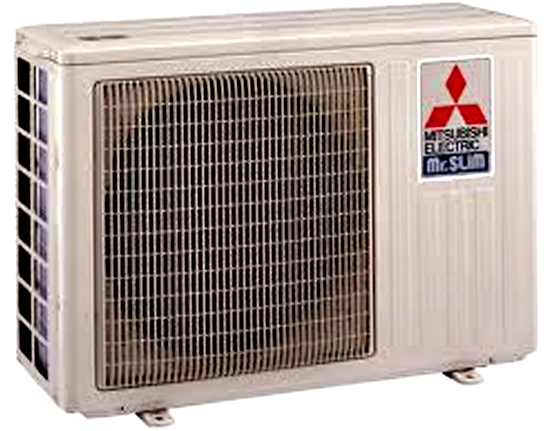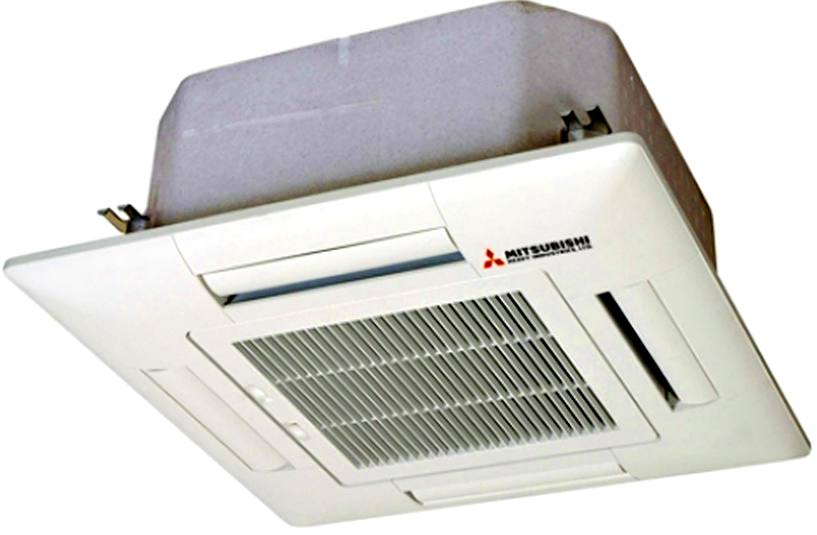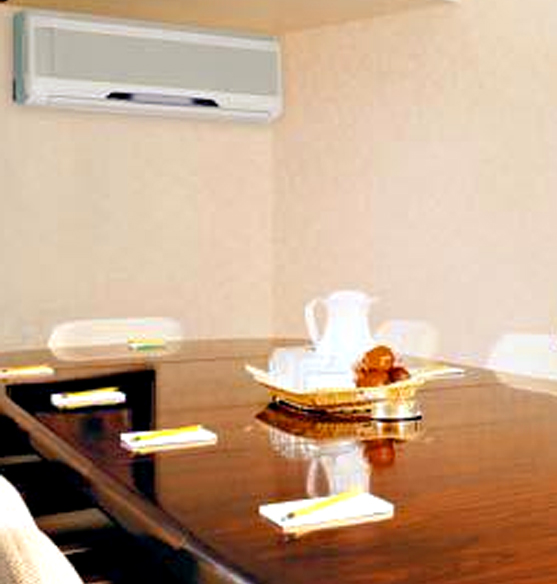VRF=Variable Refrigerant Flow HVAC (Heating, Ventilating & Air-Conditioning) systems. Rand Soellner, ArCH/NCARB/LHI, Senior Staff Architect of the HOME ARCHITECTS ®, recently took a CEU (Continuing Education Unit) course about VRF systems for HVAC systems in house and building design.
This architectural firm is all about Energy Efficient residential design and is always looking for ways & means to offer their clients improved options for the various systems in their projects.
Most people probably believe that what they see in a hotel room for the wall-mounted HVAC unit is what this is. It could be, but probably isn’t. Hotel units are typically Split-Ductless, which is sort of halfway to the VRF system.

Image courtesy of Mitsubishi Heavy Industries, Ltd..
Click on the image above to see this Architect’s Contact Us page.
Designing Houses Using VRF HVAC
There are 3 main HVAC options:
1. Traditional HVAC Systems
These are usually made up of an exterior heat pump or compressor and an interior AHU (Air Handling Unit) and has hundreds of feet of ductwork connected to the AHU to distribute air through your house.
2. Split-Ductless Systems
The main HVAC components reside in a separate housing, although they can be in the same unit, as in a hotel room “package unit”. There is an outdoor component with the compressor, condensor, fan, heat exchanger & electronics. There is an interior element which has a heat exchange coil, air filter, signal receiver and fan. The exterior and interior parts are connected with wiring and refrigerant piping. This system, while running is really all-on or all-off at one speed, even though the interior control gives the illusion of different levels, mainly due to fan settings.
3. VRF Systems
VRF is a flexible option to the 2 other traditional HVAC systems. This type of system typically has 2 distinct parts: an exterior heat pump or compressor, which is often ground-mounted, chilling the refrigerant, then an interior fan-coil unit that can be mounted above a ceiling, under a floor, sitting on a floor in the space, or wall-mounted. These units are typically very quiet in operation, because the noisier component is outside on the ground. The VRF system is able to control the flow of refrigerant variably, adjusting that flow to where and when various interior units in the system call for it. This provides better zone control and a more efficient operation. Also, because there are no ducts, there is a 30% savings over most conventionally ducted HVAC systems, that normally is wasted heating and cooling the ducts themselves, while transporting the conditioned air. VRF sends a variable flow of refrigerant through its insulated piping to the various interior fan-coil units, rather than pushing large quantities of air through ducts.

Image courtesy of Mitsubishi Heavy Industries, Ltd.
Click on the image to see this Architect’s Project Index.
ECONOMICS OF THE OPTIONAL HVAC SYSTEMS
Of course, not having to install ductwork is a huge cash savings to anyone’s budget for the initial cost of construction, as well as on-going operational cost, because of the 30% energy savings wasted in heating and cooling the interior of the ductwork while transporting treated air.
This architectural firm is very interested in energy efficiency and economics. They are one of the few Energy Star Partner Architects designing houses in the USA today.
HEALTH BENEFITS
There are companies these days who make their living cleaning the interior of ducts. Why? Because the inside of ducts are normally filthy: They are breeding grounds for mold, gather dust, and can be highways for creepy-crawlies, due to their unsupervised locations. Totally eliminating ductwork results in this dust-laden zone being removed from your house. If you might be interested in more information about Health Home Design, click here: Health Home Design.
CONFIGURATIONS
When first coming onto the market, VRF systems were primarily offered as “mini-splits” with much smaller components, with a small heat pump (or compressor) outside, ground-mounted, and a single interior fan-coil unit, often wall mounted, and that was that.

Image courtesy of Mitsubishi Heavy Industries, Ltd.
Click the image to see another article from this Architect about Indoor Air Quality in house design.
However, today’s VRF systems are capable of handling an entire house, or large office building or hotel, for that matter, using one or more exterior ground mounted heat pumps/compressors, that feed multiple interior fan-coil units, distributed throughout the office building, or house. All elements are connected with control circuitry and wiring and other control mechanisms that allow the flow of the refrigerant to go where it is needed for comfort cooling or heating, where ever and whenever required, even providing heating at some units and cooling at others at the same time! Now that’s a trick you won’t see from your average conventional house HVAC system!
PROVEN INSTALLATIONS AT MAJOR FACILITIES
Lest anyone think that this technology needs time to prove itself; it already has.
Georgia Power used a VRF system for their Coastal Regional Office, resulting in a LEED (Leadership in Energy and Environmental Design) Platinum Certification for their renovation of an historic 2-story office building.
The LiveStrong Foundation in Austin, Texas, used a VRF system to save on construction cost and also to minimize the visual impact of HVAC on the 30,000 SF (Square Foot) project. The project was so successful in terms of energy savings that it received Austin’s first LEED Gold-Certification (a significant energy conservation award).
In Athens, Georgia, the Hotel Indigo used a VRF system for their 5-story facility and became one of the first five LEED Gold-Certified buildings in the USA, in part due to the VRF system.
In Portland, Oregon, Mercy Corps, a global humanitarian organization, used VRF for their HVAC system for their new world headquarters, in a 42,000 SF facility. This, along with other green design features allowed them to surpass LEED Platinum status for energy conservation.
COMPANIES OFFERING VRF SYSTEMS
Mitsubishi Electric is one of the leading manufacturers of VRF systems today, headquartered in Suwanee, Georgia, USA.
Contact this Architect:
